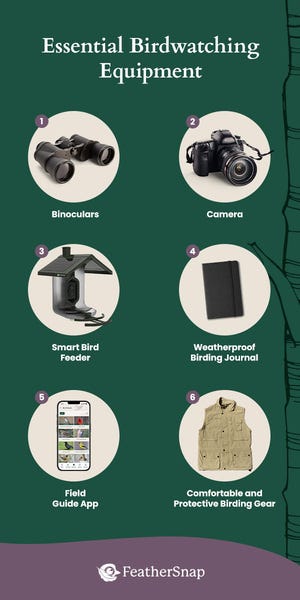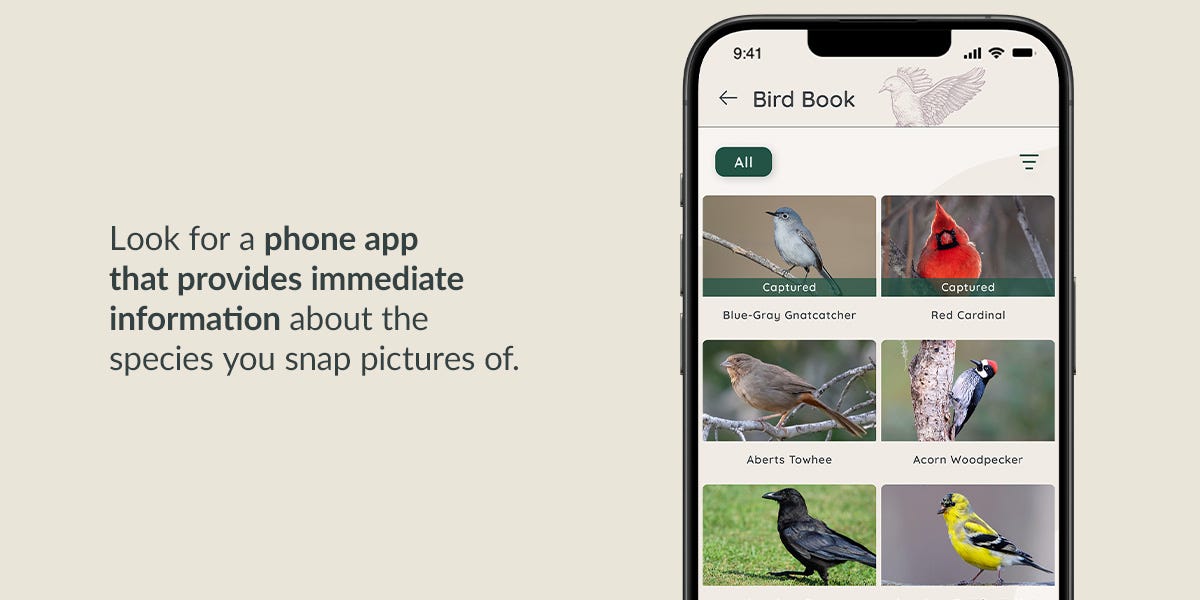

Birding is a rewarding hobby because there's always something new to learn. Whether you travel to faraway countries or wander deep in the woods to find a rare local species, you benefit from taking breathtaking photos, finding beautiful birds or learning a new way to identify different bird species.
We created this comprehensive guide to welcome you to the wonderful world of birdwatching. You'll find everything you need to know here, from must-have equipment to the best observation techniques.
Essential Birdwatching Equipment
You'll want some birdwatching gear to give you the most immersive experience and protect yourself from Mother Nature's whims. Let's explore must-have birding equipment like field guide apps, binoculars, protective gear and optional accessories like birdwatching vests and waterproof birding journals.

1. Binoculars
Sometimes, you'll need to observe from afar to avoid startling birds. Binoculars let you get a closer look without disturbing shy species. Compare your options and look for ones with a good field of view, optic quality, magnification and durability.
2. Camera
Every birder needs a camera to capture images of beautiful birds you encounter and document rare sightings. When buying a camera, choose one with good quality, zoom functions and a lightweight build.
3. Smart Bird Feeder
Did you know you can birdwatch without leaving the comfort of your home? Smart bird feeders are all-in-one technology with a high-definition camera. The FeatherSnap Scout has an AI feature that identifies your avian visitors in real time and provides detailed insights about each species.
4. Weatherproof Birding Journal
Birding journals can be a fun way to keep track of birds and birding insights you've gained along the way. If you're birdwatching in the rain or humid weather conditions, weatherproof birding journals may be perfect for writing vital notes on the go and sketching a quick illustration.
5. Field Guide App
Bird identification apps help identify the different birds you see or hear. Whether you record the bird's songs or snap a picture of one, these apps can tell you what bird you saw and provide a detailed description to improve your birding skills.
6. Comfortable and Protective Birding Gear
Investing in protective birding gear can offer you a better experience.
- Insect or mosquito repellent: Insect repellent is essential when you're birding deep in nature. Choose one that's lightweight and eco-friendly so it's safe to use around birds and other wildlife.
- Sunscreen: Broad-spectrum sunscreen with an SPF of 30 or higher is your year-round best friend, protecting your skin from damaging UV rays.
- Winter touchscreen gloves: If you're birding in the winter, specialized gloves warm your hands and let you use your smartphone without taking them off.
- Waterproof hiking boots: Some birdwatching trails might include watery patches, muddy paths and rocky terrains. Waterproof hiking boots with good ankle support can help you focus on birding and enjoy the trip.
- Long pants: Be sure to wear long pants you can tuck into your socks to protect yourself from insects and ticks.
- Birdwatching vest: These vests are a must-have for serious birders. They have multiple pockets for your water bottle, notebook, binoculars, camera and more.
Selecting a Birding Location
Birds have adapted to live in every habitat on our planet. Still, many novice birders start small by putting up a welcoming feeder or birdbath and observing the local species that visit. Once you start looking, you may be pleasantly surprised to see how many birds come and go throughout the day.
When you're ready to branch out, you can explore local parks, nature reserves and other nearby birding hot spots. Look online to find recommendations for the best locations and times of day to visit. You can also download a birding app to learn favorite hangout spots for the species you hope to see.
Different species have unique preferences. Some may like shrubs and open fields, while others make nests in tall trees or sit beside rivers and streams. Even if you live in a city, you can head to green spaces and local parks.
If you love traveling, plan to visit globally famous birding areas to glimpse rare birds worldwide. Before buying your plane ticket, research the best seasons to visit for a chance to catch the species you hope to see.
Basic Bird Identification Guides
Bird identification guides are a valuable tool that teaches you how to recognize species by their size, unique colors and markings. As a birdwatching beginner, you can start with a simple guide introducing you to easily recognizable birds in your geographic region.
These field guidebooks document local bird species, offering detailed descriptions and images for easier identification. If you'd rather go high-tech, look for a phone app that provides immediate information about the species you snap pictures of.
When you're looking for specific information about a species or just got home from your birding trip and wish to know more, a book or app might offer fascinating, in-depth insights.
Understanding Bird Behavior
When you observe different behaviors in particular species, you'll better understand what you see and hear. Familiarize yourself with bird behavior to avoid disrupting mating or nesting activities. It can also be fun to sharpen your birdwatching techniques and catch pictures at the perfect moment.
Here are a few ways to recognize common bird behavior.
- Singing: Birds either sing to attract potential partners, defend their territory or warn away a competitor. You might learn the difference between songs after birding for some time.
- Bird calls: Birds use calls for various reasons. While some might warn flock members of a threat, others might signal a bird's location.
- Feeding: Birds' beaks have adapted to different kinds of foods and eating. Finches sit silently and crush seeds, flycatchers push off their perches and catch flying insects on the wing and vireos creep through leaves.
- Nesting: You'll know birds are nesting when you hear frequent chirping coming from a particular spot or see them flying back and forth with twigs, grass and leaves in their beaks. You may find nests in shrubs, trees or hedges.
- Mating: Recognizing courtship behavior can help you distinguish between male and female birds. To attract a mate, male birds sing, dance or show off their feathers. Some may even bring food to the females.
Patience and Observation Techniques
Patience is crucial for birdwatching. Spotting the bird you've been looking for or snapping the perfect nature shot may require you to sit still for long periods. By having good observation skills — which go hand-in-hand with birdwatching — you will improve your bird identification skills and quickly identify behaviors like breeding, migration and feeding.
With time, you'll confidently spot birds because you've learned to pay attention to the finer details of the environment. Here are a few techniques you might try:
- Listen for bird calls and songs to figure out what they signify.
- Familiarize yourself with plumage patterns and behavior by paying attention to colors, sizes and shapes.
- Study field guides with pictures and detailed information.
- Install a video feeder to observe backyard birds without disturbing them.
- Try practicing mindful birdwatching by respecting birds' privacy and habitats.
Recording Bird Sightings
Logging your bird sightings is a fantastic way to keep track of your progress as a birder. Again, you can keep a hard-copy birding journal or go digital with a birding app.
Many beginners enjoy watching and learning the species that visit their backyard or a nearby park. Start by jotting down the bird's species name and the date and place you saw it.
As you grow more experienced, you might start making notes about the weather conditions on that day, sketches or specific details you want to remember. Recording the weather can be valuable if you want to find a species again to record more about them and need to know their preferences.
If your records become intricate, creating an Excel sheet for more space to put all the information is handy if you can't get clear photos. You can also make a checklist to keep track of the birds you've seen. Using a birding app may give you insights that help you start an accurate list.
Birding Ethics and Conservation
While birdwatching, you should abide by particular birding ethics codes and rules for the safety of the animals. These responsible birding practices promote the well-being of birds and their environment. You don't want to disturb birds during sensitive times when they are mating or nesting. You can avoid exposing them to harm or excess stress by following these ethical practices.


Some state laws, such as in California, prohibit birders from using flashlights to view birds, broadcasting recorded vocalizations of endangered species to attract them or using any other audio to attract birds. Here are some rules you can follow to respect birds and their habitats while birdwatching:
- Give the birds space by staying a respectable distance from their nests and being quiet.
- Never touch nests because your scent may linger, putting the birds at risk from predators like cats and raccoons.
- Be cautious when taking photos or videos around active nests to support the conservation of birds and their habitats. For your safety, never go off-trail.
- Check specific laws in the location you visit and follow them accordingly.
Birding ethics also involve respecting other birders and remembering that public spaces are open to everyone. Be sure to be supportive and helpful to fellow birdwatchers. If you notice unethical birding behavior, try to approach the situation positively, respectfully and sensitively. Then, teach by example and introduce people to the birding ethics code.
Connect With the Birding Community for Further Learning
Find fellowship and gain experience by joining local birding groups and clubs. The members can help you grow as a birder and get help when needed. Connect with people who share your passion by attending birding events like workshops and guided bird walks. You can find these communities through Facebook or a local park website.
Starting a new hobby can be exciting, but you may have more questions than answers. Search for active online platforms and bird identification apps. You can meet with other birders in forums and social media groups, or read our blog for an informative resource.
If you're looking for a more immersive experience, documentaries like “Our Planet: Birds of Paradise” and birding books like “Sibley’s Birding Basics” by David Sibley are excellent starting points!
Start Your Birdwatching Adventure With FeatherSnap Scout
Successful birdwatching starts with being well-informed. Having the appropriate equipment, gear, observation techniques and insights can create memorable experiences that motivate you to keep birding and looking for more exciting finds.
Become an expert backyard birder with FeatherSnap Scout. This Wi-Fi and solar-powered smart feeder captures high-resolution images of avian visitors, while the companion mobile app notifies you in real time and identifies the species for you. Get the Scout smart bird feeder today for an enhanced birdwatching experience!



